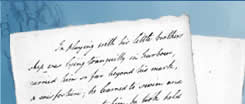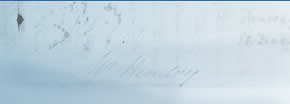| Fleurieu, Charles Pierre Claret, Comte de
|
| 1738-1810. Napoleon's Navy Minister, responsible for funding Nicolas Baudin's expedition to Terra Australis; Baudin named Fleurieu Peninsula after him. Flinders wrote a 'memorial' to Fleurieu while imprisoned on the Ile de France, requesting Fleurieu's assistance in obtaining his release. |
|
| Flinders family
|
| Dr Matthew Flinders of Donington was a widower with five children - John, Matthew, Samuel, Elizabeth and Susanna(h) - when he married Elizabeth Weekes. John was sent to the York Castle lunatic asylum at age 19; Elizabeth died when only 24; Susanna(h) married George Pearson and had eight children; Samuel married and had three daughters and a son whom he called Matthew. Dr Flinders and his second wife had two daughters, Hannah and Henrietta. Hannah married Joseph Dodd; Henrietta married James Chambers. |
|
| Flinders, Elizabeth
|
| Matthew Flinders' stepmother; née Elizabeth Weekes. Referred to in his letters etc as 'my mother-in-law'. |
|
| Flinders, Henrietta
|
| Matthew's cousin. Nicknamed Henny. Governess to the family of Captain (later Admiral Sir) Thomas Pasley who sponsored Flinders' service in the Royal Navy. Married John Newbald. |
|
| Flinders, Matthew
|
Born 16 March 1774 at Donington, Lincolnshire. Joined the Royal Navy in 1789 sponsored by Captain (later Admiral Sir) Thomas Pasley. Sailed with Captain William Bligh as Midshipman on the latter's second breadfruit expedition to the Pacific in 1791-93 in HMS 'Providence'. Took part in the naval action 'Glorious First of June' in 1794 in the 'Bellerophon' with Pasley. In 1795, he sailed as Master's Mate in the 'Reliance' under Captain Henry Waterhouse to the colony of New South Wales. With George Bass, surgeon of 'Reliance' (and Bass's boy servant William Martin) in 1796 he explored the reaches of Botany Bay in the first 'Tom Thumb', an 8-ft open boat. In 1798, in the 'Francis' he explored the Kent Group off Van Diemens Land (Tasmania). In command of the 'Norfolk' in 1798 he proved conclusively that there was a strait between the mainland and Van Diemens Land - and named it Bass's Strait after his great friend. Still in command of the 'Norfolk', he sailed northward in 1799 where he explored and charted areas around present-day Moreton and Hervey Bays in Queensland. Sailed back to England in 1800.
Appointed Lieutenant in command of the 'Investigator' (formerly the 'Xenophon') to lead a voyage of discovery around Terra Australis (Australia) 1801-03. Promoted to Commander in February 1801. Married Ann Chappelle on 17 April 1801. Successfully circumnavigated the continent of Australia and returned to Port Jackson in 1803. With the 'Investigator' condemned as unseaworthy, Flinders set sail in the 'Porpoise' to England in 1803 and was wrecked on uncharted reefs (now called Wreck Reef) off the Queensland coast. With 13 men he sailed back to Sydney in the ship's cutter to get help - a remarkable 1127 km (700 mile) journey. Set sail in another vessel - the 'Cumberland' - and rescued the survivors ('Rolla' and 'Francis' accompanied him to Wreck Reef). Continued to England but was forced to stop in December 1803 at Ile de France (Mauritius) for supplies and repairs. England was back at war with France and he was detained as a suspected spy for seven years. During this time he completed work on his charts and narrative and wrote a paper on a method of compensating for compass deviations caused by iron in a ship.
Released finally in 1810 (even though De Caen had received papers ordering his release in 1807), he returned to his family. Appointed Post Captain on his return in October 1810. Completed his experiments on compass deviations and his great work 'A Voyage to Terra Australis'. It was published the day he died, 19 July 1814, aged 40. Survived by his wife Ann and daughter Ann (born 12 April 1812). He was the first consistently to use the term 'Australia' and to confirm that the west (New Holland) and the east (New South Wales) were part of the one landmass. His charts became the basis of the Australian hydrographic record.
For additional information see the essay Flinders and the voyage of the 'Investigator' in the 'About Flinders' section of this site. |
|
| Flinders, Samuel
|
| 1782-1834. Matthew's younger brother; named after their uncle, Samuel Ward. Sailed with Flinders in HMS 'Reliance' in 1795 to New South Wales. Was Second Lieutenant on HMS 'Investigator'. Not with Flinders when the latter was imprisoned on Ile de France. Court-martialled after an incident on the 'Bloodhound' where he was commander. Buried at Donington Parish Church, Lincolnshire. Flinders Island in South Australia is named for him. |
|
| Fowler, Robert
|
| First Lieutenant, HMS 'Investigator'. Had served on the ship when it was 'Xenophon'. |
|
| Franklin family
|
| Step-cousins to the Flinders. Matthew's stepmother Elizabeth Weekes had a sister called Hannah who married Willingham Franklin. Willingham and Dr Flinders (Matthew's father) were friends. Hannah and Willingham Franklin were the parents of John, Thomas, James, Willingham(?), Mary and Elizabeth Franklin. |
|
| Franklin, Elizabeth
|
| John and Thomas Franklin's sister. Called Betsey by family and friends. |
|
| Franklin, John
|
| 1786-1847. Flinders's step-cousin. Born in Spilsby, Lincolnshire. Served in HMS 'Polyphemus' at the Battle of Copenhagen. Midshipman and Master's Mate on HMS 'Investigator'. Fortunately did not sail with Flinders in the 'Cumberland' back to England and so avoided sharing Flinders's captivity on the Ile de France. Joined 'Bellerophon' (Flinders's old ship) as signal officer under Captain John Cooke in the Mediterranean. Joined the 'Bedford' in 1807 and was made Lieutenant in 1808. Was wounded during an attack against New Orleans in 1814. In 1815 he was First Lieutenant on the 'Forth'. His first command was in 1818 in the brig 'Trent'. Under Captain Buchan the 'Isabella', 'Alexander', 'Dorothea' and 'Trent' explored the Polar Sea north of Spitzbergen. He was made Post Captain in 1821, and also a Fellow of the Royal Society. In 1825 he explored the North-West territory. Knighted in 1829. Governor of Van Diemens Land (Tasmania) 1836-43. Left in 1845 in command of 'Erebus 'and 'Terror '(Captain Francis Crozier) in an attempt to find the North-West Passage. Never seen again, though 39 expeditions were sent out in search of them. It was not until 1859 that evidence was found - the log, which showed that Franklin had survived until 1847. |
|
| Franklin, Mary
|
| John and Thomas Franklin's sister, and sister of Betsey (Elizabeth). The Franklin family were step-cousins to the Flinders. |
|
| Franklin, Thomas
|
| One of Flinders's best friends and John Franklin's brother. (The Franklins and the Flinders were step-cousins.) |
|
| Frome, (Captain)
|
| 1802-90. Third South Australian Surveyor-General in 1839. |



